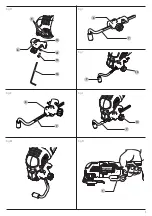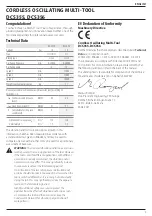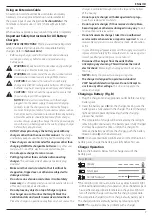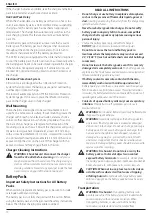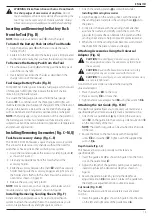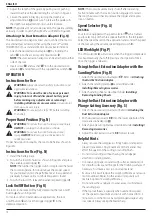
8
English
Additional Safety Rules for Oscillating
Multi‑Tool
WARNING:
Take special care when sanding some woods
(e.g. beech, oak) and metal which may produce toxic dust.
Wear a dust mask specifically designed for protection
against toxic dust and fumes and ensure that persons
within or entering the work area are also protected.
WARNING:
Use this tool in a well-ventilated area when
sanding ferrous metals. Do not operate the tool near
flammable liquids, gases or dust. Sparks or hot particles
from sanding or arcing motor brushes may ignite
combustible materials.
Sanding Paint
WARNING:
Observe the applicable regulations for
sanding paint. Pay special attention to the following:
• Whenever possible, use a vacuum extractor for dust collection.
• Take special care when sanding paint which is possibly
lead based:
- Do not let children or pregnant women enter the
work area.
Chargers
D
e
WALT
chargers require no adjustment and are designed to be
as easy as possible to operate.
Electrical Safety
The electric motor has been designed for one voltage only.
Always check that the battery pack voltage corresponds to the
voltage on the rating plate. Also make sure that the voltage of
your charger corresponds to that of your mains.
Your
D
e
WALT
charger is double insulated in
accordance with EN60335; therefore no earth wire
is required.
If the supply cord is damaged, it must be replaced by a
specially prepared cord available through the
D
e
WALT
service organisation.
Mains Plug Replacement
(U.K. & Ireland Only)
If a new mains plug needs to be fitted:
• Safely dispose of the old plug.
• Connect the brown lead to the live terminal in the plug.
• Connect the blue lead to the neutral terminal.
WARNING:
No connection is to be made to the
earth terminal.
Follow the fitting instructions supplied with good quality plugs.
Recommended fuse: 3 A.
Residual Risks
In spite of the application of the relevant safety regulations
and the implementation of safety devices, certain residual risks
cannot be avoided. These are:
• Impairment of hearing.
• Risk of personal injury due to flying particles.
• Risk of burns due to accessories becoming hot
during operation.
• Risk of personal injury due to prolonged use.
SAVE THESE INSTRUCTIONS
b )
Use power tools only with specifically designated
battery packs.
Use of any other battery packs may create
a risk of injury and fire.
c )
When battery pack is not in use, keep it away from
other metal objects, like paper clips, coins, keys,
nails, screws or other small metal objects, that can
make a connection from one terminal to another.
Shorting the battery terminals together may cause burns
or a fire.
d )
Under abusive conditions, liquid may be ejected
from the battery; avoid contact. If contact
accidentally occurs, flush with water. If liquid
contacts eyes, additionally seek medical help.
Liquid
ejected from the battery may cause irritation or burns.
e )
Do not use a battery pack or tool that is damaged
or modified.
Damaged or modified batteries may exhibit
unpredictable behaviour resulting in fire, explosion or risk
of injury.
f )
Do not expose a battery pack or tool to fire or
excessive temperature.
Exposure to fire or temperature
above 130 °C may cause explosion.
g )
Follow all charging instructions and do not charge
the battery pack or tool outside the temperature
range specified in the instructions.
Charging
improperly or at temperatures outside the specified range
may damage the battery and increase the risk of fire.
6) Service
a )
Have your power tool serviced by a qualified repair
person using only identical replacement parts.
This
will ensure that the safety of the power tool is maintained.
b )
Never service damaged battery packs.
Service
of battery packs should only be performed by the
manufacturer or authorized service providers.
- All persons entering the work area should wear a mask
specially designed for protection against lead paint dust
and fumes.
- Do not eat, drink or smoke in the work area.
• Dispose of dust particles and any other removal debris safely.
•
Hold the power tool by insulated gripping surfaces,
when performing an operation where the cutting
accessory may contact hidden wiring.
Cutting accessory
contacting a "live" wire may make exposed metal parts of the
power tool "live" and could give the operator an electric shock.
•
Use clamps or another practical way to secure and
support the workpiece to a stable platform.
Holding the
work by hand or against your body leaves it unstable and may
lead to loss of control.
Summary of Contents for DCS356N
Page 1: ...DCS355 DCS356 ...
Page 2: ...B Copyright DeWALT English original instructions 5 ...
Page 3: ...1 Fig A Fig B 4 1 3 2 10 DCS356 DCS355 6 7 9 8 11 5 8 9 9 8 XXXX XX XX 25 ...
Page 4: ...2 Fig C Fig D Fig E Fig F Fig G 3 22 24 23 16 18 12 20 ...
Page 5: ...3 Fig H Fig I Fig J Fig K Fig L Fig M Fig N 14 7 1 14 7 7 6 6 7 16 15 21 13 5 6 ...
Page 6: ...4 Fig O Fig P Fig R Fig S Fig Q 2 4 1 13 17 15 16 5 21 17 23 17 19 ...
Page 18: ......
Page 19: ......





